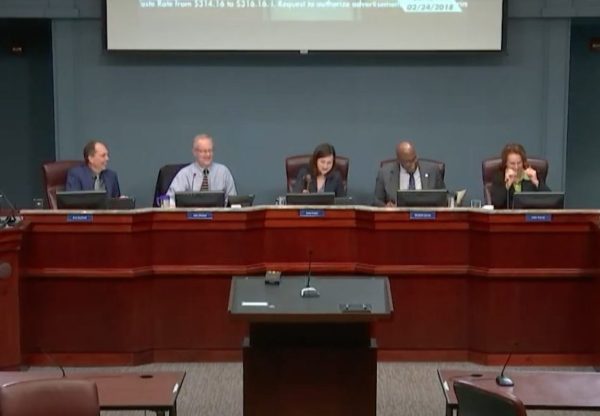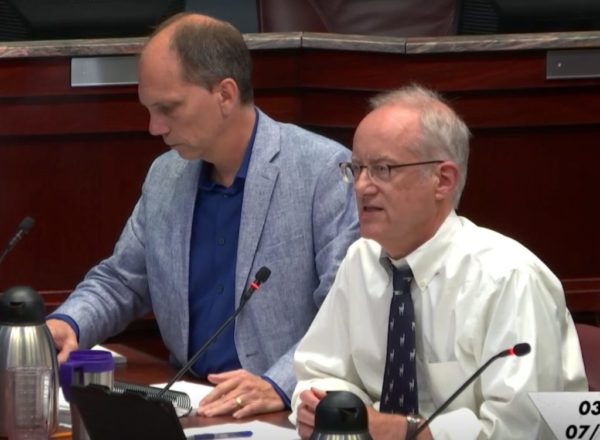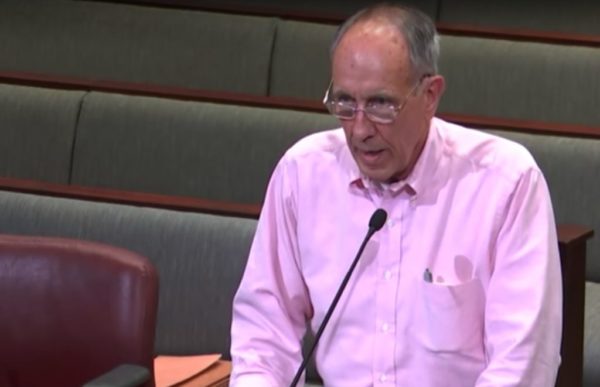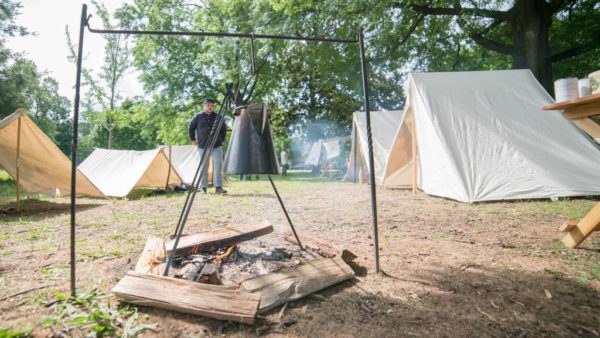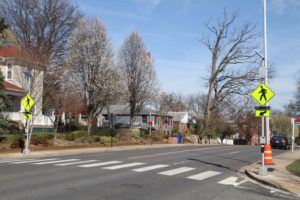Though it comes with some painful cuts and delays a variety of anticipated projects, a 10-year, $3.4 billion construction spending plan won the County Board’s approval this weekend.
The Board unanimously signed off on a new Capital Improvement Plan, commonly known as the CIP, at its meeting Saturday (July 14), marking an end to its months-long work to wrestle with the county’s budget pressures and lay out a new blueprint for major construction projects through 2028.
Ultimately, Board members made relatively few changes to County Manager Mark Schwartz’s proposed CIP, but did manage to find an extra $1 million for the Neighborhood Conservation program.
That means the program, designed to fund local infrastructure projects like sidewalk improvements or new landscaping, will have $37 million to work with over the next decade instead of $36 million, even though community leaders still fear the $23 million funding cut will imperil Neighborhood Conservation’s future. The Board also formalized plans to study potential reforms to the program, in order to ensure its long-term survival.
By and large, however, the Board didn’t have much leeway to pump much additional money into the CIP, considering that the county remains constrained by challenging factors like a decrease in commercial tax revenues and an increase in the amount of cash it needs to send to Metro as part of a deal to provide the service with dedicated annual funding.
“It’s kind of a carrots and peas CIP, rather than a steak and asparagus CIP,” said Board member John Vihstadt. “It’s a realistic one for where we are at this point in time, given our economic circumstances and near-term challenges ahead.”
Board generally members struck an optimistic tone about the CIP Saturday, but there is little doubt that they’re already looking ahead anxiously to 2020, when the Board will revise the spending plan once more. By then, the county’s revenue picture could improve, or lawmakers in Richmond could answer Arlington’s pleas and tinker with the Metro funding deal to free up more money for Northern Virginia transportation projects.
“In two years, we’re either going to have a lot more money or we’re going to have a lot less,” said Board member Libby Garvey.
That’s why Board Vice Chair Christian Dorsey stressed that he looks at the CIP as “a two-year document and an eight-year math exercise.” He was particularly adamant that parents concerned about school funding shouldn’t view this spending plan with trepidation, even as debate simmers over how the school system builds new space for high schoolers at the Arlington Career Center.
The Board’s CIP includes $614 million to fund the school system’s own construction plan, and the county wasn’t able to find much in the way of additional money to fund some of the more ambitious construction plans the School Board considered. Yet Dorsey is broadly optimistic that this new, limited CIP is far from the end of Career Center discussions.
“When our needs become more clear in the coming years, whether it’s schools or county facilities as well, and we’re able to price them out more, we’ll figure out how to pay for it,” Dorsey said.
There are certainly plenty of other cuts in the CIP the Board hopes to someday revisit. For instance, the plan pushes out the construction of second entrances at the Ballston, Crystal City and East Falls Church Metro stations far into the future, and cuts funding for improvements on some of the county’s arterial roads.
The CIP also contains only limited funding for planning at the Buck and Carlin Springs Road properties, a pair of sites officials have long eyed as potential homes for new schools or county facilities someday.
However, the plan does maintain funding for previously approved capital projects like a new Lubber Run Community Center and a replacement for Fire Station 8 on Lee Highway.
Board members were also eager to reiterate their support for the Long Bridge Park aquatics center. The project isn’t funded as part of this CIP, yet the county’s strained financial picture has nonetheless convinced some in the community to agitate for the pool’s delay or cancellation, in favor of sending its funding elsewhere.
“To try to cancel the contract now is not reevaluating past decisions in light of new information,” said Board Chair Katie Cristol. “To cancel a contract that breaks ground in a week would be setting a toxic precedent.”
Vihstadt, the lone Board member to vote against a slimmed-down version of the project last fall, reiterated his belief Saturday that the project should be delayed. Yet he also signalled that he was willing to let the matter go, for now.
“We had a vote last December, I was in the minority, I acknowledge it and I accept it,” Vihstadt said. “But I have no doubt if this process were going forward today, or if there were a vote on this particular issue today by the voters of Arlington, it would fail.”
Amid concerns about deep cuts on the way for the Neighborhood Conservation program, the County Board is kicking off a new effort to identify some potential reforms.
The Board decided Tuesday (July 10) to direct County Manager Mark Schwartz to draw up a process for studying the program in more depth over the next two years or so, in order to better understand how it can become more efficient and see where it might overlap with other county efforts.
“By adopting this, we’re saying, no, we’re not looking for a slow, or any kind of, death [for the program],” said Board member Erik Gutshall. “But we’re taking a moment here to hit the reset button and double down on the program, to invest the time and staff resources to study remaking the program to meet its original goals.”
Neighborhood Conservation was formed in 1964 as a way for communities to lobby for money to complete modest infrastructure projects, like new sidewalks or landscaping, but Schwartz targeted it for hefty cuts in his proposed 10-year Capital Improvement Plan.
In all, the program is set to lose $24 million over the next decade, leaving $36 million in its coffers to finish out existing projects selected for funding between now and 2028. Some civic association leaders have charged that such a steep cut amounts to killing the program in its entirety.
Others in the community have countered that the program may very well need to end, considering that the cost of projects funded through Neighborhood Conservation have shot up in recent years.
Tuesday’s decision by the Board essentially represents a middle ground between those two positions. The county’s tight financial position means it likely won’t be able to avoid some steep cuts to the program, but Board members also believe they can pursue some changes to Neighborhood Conservation to ensure its long-term viability.
“Hopefully, this keeps faith with the communities, while at the same time acknowledging the reality that the program has had some challenges,” said Board member John Vihstadt.
Vihstadt hopes the review of the program will provide a “holistic, countywide perspective,” including whether the county might be better served by directing Neighborhood Conservation funding to its “Complete Streets” program instead.
Schwartz is set to establish a working group and lay out a timeline for a review process by Sept. 30, with the ultimate goal of having results in hand by the time the Board reviews its next CIP in 2020.
In the near term, Board Chair Katie Cristol suggested sending a smidge more money to the program as “a show of faith.” County staff managed to earn an unexpected $1 million in state funding for some construction at one of Arlington’s group homes for adults with disabilities, and Cristol suggested using the savings to fund one additional Neighborhood Conservation project.
Yet the Board has plenty of other pressing needs left unaddressed by a challenging CIP, and Cristol’s colleagues didn’t immediately sign off on such a change.
The Board is set to finalize the CIP when it reconvenes Saturday (July 14).
Supporters of Arlington’s Neighborhood Conservation program are warning county leaders that the steep budget cuts they’re contemplating could effectively kill it.
County Manager Mark Schwartz is proposing slashing $24 million from the program’s funding over the next 10 years as part of his new Capital Improvement Plan, dropping its coffers down to $36 million through 2028.
Neighborhood Conservation has long helped dole out money for modest community improvements, like new sidewalks or landscaping, yet the county’s grim budget picture convinced Schwartz to target it for some hefty cuts. That prompted several community activists and managers of the program to lobby the County Board to restore that funding at a public hearing last Wednesday (June 27).
“This is almost a death knell for Neighborhood Conservation,” said Bill Braswell, a former chair of the county’s Neighborhood Conservation Advisory Committee. “All the interest in it will dissipate, and it will take forever to get started again.”
County staff say that these proposed cuts would mean that projects already in line for funding will still move ahead, but any new applications from neighborhoods will go on the back burner. Accordingly, Phil Klingelhofer, deputy vice chair of the program’s advisory committee, believes that such a delay would mean that any “neighborhood with a recently proposed project should expect to wait 15 to 30 years for a project to come to the top for current funding.”
“If you decide to accept this… we recognize this is really the end of the program, and at that point, you should take the final step and end the program permanently,” Klingelhofer said.
For some in the community, that doesn’t sound like such a bad idea. Some activists have started arguing that the program has outlived its usefulness, including columnist Peter Rousselot, who points out that it can already take five or 10 years for a project to move through the Neighborhood Conservation process.
County Board member John Vihstadt has similar concerns about the program’s efficacy, noting that those delays are often driven by “quality control or monitoring issues” with the county switching contractors for some projects two or three times each. That’s why he sees this CIP process has a chance to reform the program, and “mend it, not end it.”
“Things are not good right now, and we’re looking at what we’re going to do,” Vihstadt told ARLnow. “If we’re going to fund the program, it needs to be modified and reformed.”
Braswell and Klingelhofer both told the Board at the hearing that they’d be willing to study ways to make the program run more efficiently, particularly if the alternative is steep funding cuts.
Arlington Falls in Parks Ranking — Arlington and D.C. both fell in the annual ParkScore rankings of cities by The Trust for Public Land. Arlington was ranked sixth in the nation this year and D.C. ranked fourth, while last year they were ranked fourth and third respectively. [The Trust for Public Land, Washington Post]
Neighborhood Conservation Projects Approved — The Arlington County Board last night unanimously approved $5.5 million in neighborhood improvement projects, including “street improvements, streetlights, intersection improvements and a neighborhood sign.” [Arlington County]
How to Live in Arlington on $50,000 — A young woman who works as a case manager outlined her expenditures while living in Arlington on a $50,000 salary, as part of a “Money Diaries” feature. Eschewing the urban millennial stereotype of profligate spending, she manages to save $1,000 a month — although that is helped by her parents continuing to pay her cell phone bill. [Refinery 29]
County to Sell Millions in Bonds — The County Board has approved issuing up to $185 million in general obligation bonds to help fund various capital priorities, including: Metro, Neighborhood Conservation, paving, parks land acquisition, maintenance capital, Lubber Run Community Center planning, Nauck Village Center action plan and transportation. [Arlington County]
Flickr pool photo by John Sonderman
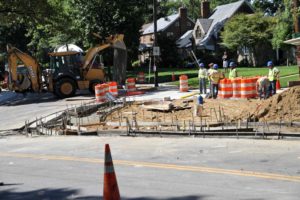 The Arlington County Board on Saturday is expected to consider five neighborhood improvement projects with a cumulative price tag of $5.3 million.
The Arlington County Board on Saturday is expected to consider five neighborhood improvement projects with a cumulative price tag of $5.3 million.
The projects have been advanced by a county committee via Arlington’s Neighborhood Conservation Program, which encourages neighborhoods to apply for funding for various types of local improvements.
The projects set for approval are:
- A new neighborhood sign for Long Branch Creek ($12,500)
- Street improvements and new streetlights along 31st Street S. in Fairlington, between S. Randolph and Woodrow Streets ($1.7 million)
- New streetlights on S. Oak, Ode and Orme Streets in Foxcroft Heights ($562,704)
- Intersection improvements along 2nd Street S. at S. Wayne, Uhle and Wise Streets in Penrose ($1.6 million)
- Street improvements along N. George Mason Drive between 11th Street N. and I-66 in Waycroft-Woodlawn ($1.4 million)
The County Board is expected to vote on the Neighborhood Conservation projects at its Saturday meeting. The measure also includes an additional $200,000 for the county’s “Missing Link Program,” which funds the construction of small stretches of new sidewalk to connect existing sidewalks.
Children already are climbing on equipment at the two newly renovated playgrounds at Woodlawn Park, ahead of this weekend’s ribbon-cutting ceremony.
The ceremony will take place at the park (1325 N. Buchanan Street) this Saturday, April 22, at 4 p.m.
Members of the community — including kids — helped design the new playgrounds. As part of the renovation process, the new equipment was installed farther away from the creek than the previous fixtures had been.
Invasive plants were removed and the area along the creek has been reforested with native trees, shrubs and perennials. The park also now offers better accessibility. Lawn aeration and overseeding will be completed next week.
The County Board approved funding for the $795,000 neighborhood improvement project in 2014, and construction began last August. A federal grant funded part of the reforestation.
The park remains open and usable in the time leading up to the ribbon cutting.
No new projects to improve pedestrian safety — such as sidewalk fixes or streetlight installations — will be approved until at least December after a vote last week by a citizen committee.
The Neighborhood Conservation Advisory Committee voted April 13 to suspend its spring funding round due to “anticipated increases in construction costs for projects that have already been approved by the County Board,” neighborhood conservation program coordinator Tim McIntosh said in an email.
NCAC represents 48 of the county’s 57 civic associations and leads the development of neighborhood plans. It also recommends neighborhood-initiated improvements for county funding, like sidewalks, street beautification, pedestrian safety projects, street lights and parks.
The NCAC’s decision does not affect existing projects already approved by the County Board. McIntosh said design work and construction on several plans will continue this year, but that the committee “wanted to reserve a portion of its 2016 bond to cover any cost overruns which may occur later this year for projects going out for competitive bid.”
“The focus will be on continuing design work for approved projects and making sure sufficient funding is on hand to complete them prior to approving new ones,” McIntosh said.
In an email, an anonymous tipster was critical of the NCAC approvals process and said more must be done to help improve pedestrian safety.
“Clearly, the NCAC system isn’t working as a method to help improve pedestrian safety,” the tipster wrote. “These projects are getting conflated with beautification projects and are now shut down due to poor project controls. The queue of vital pedestrian safety projects, many in the NCAC process for years already (projects that have neighborhood endorsement) is growing rapidly as Arlington traffic increases and there is now no way to address these problems.”
McIntosh said no decision has been made about the fall round of funding, set to be voted on in December.
“[Neighborhood Conservation] staff and the NCAC will evaluate whether or not to have the December funding round later this year,” he said.
New Restaurants Coming to Rosslyn — A bunch of new restaurants and a cafe are coming to Rosslyn as part of the under-construction Central Place project. Fast casual eateries Sweetgreen, Nando’s Peri-Peri and The Little Beet are signing deals with developer JBG. A Compass Coffee is also set to open and negotiations are reportedly underway with Cava Grill. [Washington Business Journal]
Sidewalk Cafe for Pike Beer Garden — The Arlington County Board last night approved a use permit that will allow the future beer garden at the corner of Columbia Pike and Walter Reed Drive to operate a 32-seat outdoor cafe. The outdoor seating will “enliven the restaurant space and provide greater activity on this corner” of Columbia Pike, county staff wrote. County Board members expressed enthusiasm for the business, from the owner of nearby Twisted Vines, with Jay Fisette calling it “a fabulous use for this site.” [Arlington County]
Neighborhood Conservation Projects Approved — Last night the County Board approved $4.7 million in funding for six neighborhood conservation projects. The projects include a neighborhood sign for the recently-renamed Arlington Mill neighborhood; street improvement projects in Yorktown, Waverly Hills and Lyon Park; new LED streetlights in Arlington Heights; and a vegetation and sidewalk project in Boulevard Manor. [Arlington County]
Guas Appears on ‘Chopped Junior’ — Chef David Guas of Bayou Bakery in Courthouse was back on national TV last night, starring as a judge on the Food Network show “Chopped Junior.” [Patch]
WERA Anniversary Nears — Arlington’s own community radio station WERA will be celebrating its first anniversary in just over two months. The low-power FM station is “having an impact,” with some ninety producers generating local programming. Fundraising for the station, however, has been sluggish. [InsideNova]
Fmr. Sen. Warner to Endorse Clinton — At an event in Alexandria this morning, five-term former U.S. Sen. John Warner (R-Va.) is expected to endorse the presidential ticket of Hillary Clinton and Sen. Tim Kaine (D-Va.). It will be the first time Warner has endorsed a Democrat for president. [Politico]
Flickr pool photo by Wolfkann
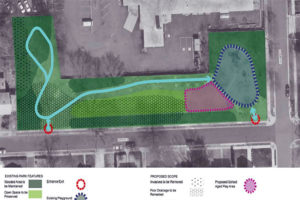 Despite vocal opposition from a few local activists, the Arlington County Board on Tuesday approved the full slate of four proposed Neighborhood Conservation projects.
Despite vocal opposition from a few local activists, the Arlington County Board on Tuesday approved the full slate of four proposed Neighborhood Conservation projects.
The County Board allocated $1.4 million for the community improvement projects, which were selected by the citizen-led Neighborhood Conservation Advisory Committee. The committee makes such funding recommendations to the Board twice a year.
Three of the projects were largely uncontroversial — a neighborhood sign for Shirlington, a beautification project for the historic Calloway United Methodist Church cemetery, and street improvements for the 4800 block of 9th Street S. The biggest recommendation, a $800,000 improvement project for Nelly Custis Park (701 24th Street S.), picked up some outspoken critics in the Aurora Highlands neighborhood.
The project would add new plantings, an ADA accessible walkway, improved storm water management and a small play area for school-aged children next to an existing playground. While supporters said most of the community was in favor of the project, a few critics launched a campaign against it, objecting mostly to the playground. Other concerns included the addition of extra pavement from the ADA pathway and “tricycle loop.”
“We heard a number of concerns from the community,” acknowledged Lisa Grandle, of Arlington’s parks and recreation department.
What’s usually an easy vote on the County Board’s “consent agenda” instead became a nearly hour-long discussion that centered around the Neighborhood Conservation process in general and the park project in particular. Board member John Vihstadt led the questioning, and attempted a motion to separate out the Nelly Custis project from the other three, for a vote in March. The motion failed.
The necessity of the conversation seemed to frustrate some Board members. “I‘m disappointed that we’re here tonight, but we’re here,” said Christian Dorsey.
In the end, the Board voted to approve the project as proposed. From a county press release:
The Arlington County Board today approved nearly $1.4 million in funding for four new Neighborhood Conservation projects. The approved projects include street improvements, neighborhood beautification, park improvements, and a neighborhood sign.
The projects, submitted by residents and endorsed by civic associations, are qualified by staff, then evaluated by the Neighborhood Conservation Advisory Committee (NCAC) before coming to the County Board for approval. The NCAC considered 31 projects at its Dec. 10, 2015 meeting and decided to recommend four of them to the County Board for funding.
The Board voted unanimously to approve funding for the four projects. To read the Staff Reporton this Item, visit the County website. Scroll down to Item #10 on the Agenda for the Saturday, Feb. 20, 2016 Regular County Board Agenda.
“We rely on residents to help us identify the best projects to make their neighborhoods safer, stronger and more attractive,” said County Board Chair Libby Garvey. “For more than 50 years, Arlington’s Neighborhood Conservation program has helped build community by funding projects identified by the people who live in the neighborhoods.”
The projects approved by the County Board today are funded by the voter-approved 2014 Neighborhood Conservation Bond. It is the third set of projects to be approved from the $12 million bond. The four approved projects are:
- $12,500 for Shirlington neighborhood sign – Location and design by the community with staff assistance. Sign fabrication, sign installation and landscaping.
- $798,222 for Aurora Highlands Park project – Improvements to Nelly Custis Park including storm water management to correct existing drainage problems; removal of invasive species; improving circulation for accessibility and park use; additional school-age play equipment; new site furnishings; and additional plantings for shade and beautification.
- $129,625 for Highview Park beautification project – Calloway United Methodist Church Cemetery improvements that include a perimeter fence, interpretive sign, a bench and trash receptacle. A public access easement over the local historic district will allow the public to visit the cemetery and interpret its history.
- $432,561 for Barcroft street improvement project – 4800 block of 9th Street S to W&OD Trail. Includes completion of missing concrete curb, gutter and sidewalk along the south side of 9th Street S, in the westerly half of the 4800 block, between S Buchanan St and the W&OD Trail. Street milling and paving as needed, including the trail connector between the street dead end and the W&OD Trail. Storm water drainage improvements and the addition of LED Carlyle-style streetlights are a part of the proposed project
The Board also approved the use of $228,000 in additional funds required for street improvements on South Fern Street (project previously approved by the NCAC at the fall 2011 funding session). This additional funding was reviewed and voted on by NCAC at its Jan. 14, 2016 meeting.
The Arlington County Board this weekend is set to consider a $1.6 million slate of minor neighborhood improvement projects.
Most of the time, such “Neighborhood Conservation” projects are uncontroversial. The latest includes a neighborhood sign for Shirlington, a beautification project for the historic Calloway United Methodist Church cemetery, and street improvements for the 4800 block of 9th Street S., which leads to the W&OD Trail in the Barcroft neighborhood.
One project, however, has resulted in a flurry of back-and-forth emails to reporters and county officials, accusations of lies and bad faith, and exhaustive five-page missives. No, this isn’t over a bocce court. It’s over a play area for 5-12 year olds in a 0.8 acre park in Aurora Highlands.
At $798,222, the Neighborhood Conservation project for Nelly Custis Park (701 24th Street S.) is the priciest item in the latest batch. The project includes new plantings, improved storm water management, removal of invasive species, a new ADA accessible walkway and — most controversially — a small play area for school-aged children next to an existing playground.
On one side are members of the “Friends of Aurora Highlands Parks” group, which formed last year to oppose a new playgrounds and athletic courts, saying that the neighborhood had enough of them already.
A member of the group, who in her latest emails asked not to be identified by name, had this to say about the Nelly Custis project: “It has been contentious and controversial from within the neighborhood from the beginning and continues to move forward with some very significant questions about tax-payer waste, process and community input.”
On the other side are residents and Aurora Highlands Civic Association members who say they’re in favor of the changes, which are coming after an extensive planning process involving the community.
“The neighborhood is in overwhelming support of the project and it has undergone an extensive (more than required) development process,” said Mary Humphreys, who’s lived in Aurora Highlands, near Crystal City, for more than 10 years. “Unfortunately, there is a very vocal resident… who is opposed to the improvements and despite many kind and collaborative efforts, he continues to spread incorrect information.”
Humphreys said the spat essentially boils down to the fact that opponents of the play area want local parks to serve “age-diverse needs” — more green space, dog park and water features, not just playgrounds.
For opponents, until the project is approved, the fight continues. On Monday, the “Friends” member who asked not to be identified wrote a letter to the County Board with a slew of questions. Among them:
“How can the public have confidence in the environmental integrity of NC park projects when the formal process fails to include a review by all relevant county commissions, including the Arlington Park & Recreation Commission and the Environment and Energy Conservation Commission?” she wrote. “No commission or committee formally reviewed this project despite requests for them to do so.”
“This is not the Arlington Way,” the letter-writer concluded.
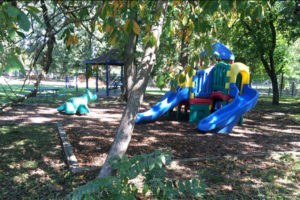 As part of the next installment of Neighborhood Conservation projects, five neighborhoods, including three along I-66, could be a getting a combined $2.6 million in infrastructure improvements.
As part of the next installment of Neighborhood Conservation projects, five neighborhoods, including three along I-66, could be a getting a combined $2.6 million in infrastructure improvements.
The Neighborhood Conservation Advisory Committee and county staff has recommended the five projects, and the Arlington County Board is scheduled to vote on whether to allocate money from the $12 million Neighborhood Conservation bond the voters approved last year.
Cherrydale’s Oak Grove Park, along N. Quincy Street, has been recommended for $795,000 worth of improvements, including a redone “tot lot,” construction of a playground for 5-12 year olds and replacing the existing gazebo with a larger picnic shelter.
Waycroft-Woodlawn is in line for $790,000 in pedestrian upgrades. The neighborhood has requested the money to fund curb ramp improvements for accessibility curb extensions at four intersections:
- N. Evergreen Street and Washington Blvd
- N. George Mason Drive and 11th Street N.
- N. Evergreen Street and 11th Street N.
- N. Buchanan St and 11th Street N.
The other projects would each receive less than $500,000 in funding:
- $471,731 in pedestrian improvements along S. Courthouse Road from Columbia Pike to 12th Street S. in Columbia Heights
- $348,987 for street lights in Madison Manor, along 12th Street N. from 11th Road to N. Roosevelt Street
- $198,033 for street lights in Douglas Park, along 12th Street S. from S. Monroe Street to Quincy Street
Five of the projects approved by the County Board in February are in the middle of their design phase and are on track for construction next year:
- Street improvements to the 5700 block of 2nd Street S. and the 100 block of S. Kensington Street in Glencarlyn.
- A trail connector from the 4800 block of 7th Street S. to the W&OD trail in Barcroft.
- Pedestrian safety improvements to 19th Road N. between Woodstock Street and Upton Street in Waverly Hills
- Street improvements to S. Lang Street between Arlington Ridge Road and 28th Street in Arlington Ridge
- Streetlights and trail improvements on N. Ohio Street between 22nd Street and Washington Blvd in Highland Park Overlee Knolls.
The sixth project approved in February, improvements to Woodstock Park in Waycroft-Woodlawn, still does not have a scheduled completion date.
Photo via Arlington County


